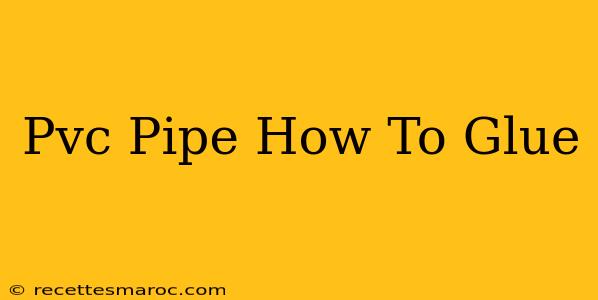PVC pipes are ubiquitous in plumbing and construction projects, offering durability and affordability. However, successfully joining PVC pipes requires proper gluing techniques. This guide will walk you through the process, ensuring your connections are strong, leak-free, and long-lasting.
Understanding PVC Cement
Before diving into the gluing process, let's understand the glue itself – PVC cement. This isn't your average glue; it's a solvent-based adhesive specifically designed to melt and fuse PVC. This creates a strong, permanent bond. Choosing the right cement is crucial; ensure it's designed for the type of PVC you're using (schedule 40, schedule 80, etc.).
Key Characteristics of PVC Cement:
- Solvent-based: It dissolves the surface of the PVC, allowing the pipes to fuse together.
- Fast-setting: It cures quickly, so work efficiently.
- Volatile: It emits fumes, so work in a well-ventilated area.
- Specific formulations: Different cements exist for different PVC types and applications.
Essential Tools and Materials for Gluing PVC Pipes
Before you begin, gather these essential supplies:
- PVC pipes and fittings: Make sure you have the correct sizes and types.
- PVC cement: Choose a reputable brand and the appropriate type for your project.
- PVC primer (optional, but recommended): Primer enhances adhesion, especially on larger diameter pipes.
- Measuring tape: Accurate measurements are critical for proper fitting.
- Pencil or marker: For marking cut lines and alignment points.
- Hacksaw or PVC pipe cutter: Clean cuts are essential for a secure seal.
- Rags or cloths: For cleaning up spills and excess cement.
- Safety glasses and gloves: Protect yourself from fumes and accidental splashes.
Step-by-Step Guide to Gluing PVC Pipes
Now, let's go through the process of gluing PVC pipes effectively:
Step 1: Preparation is Key
- Clean the surfaces: Ensure both the pipe and the fitting are clean, dry, and free of debris. Any dirt or moisture can prevent proper adhesion.
- Dry-fit the pieces: Before applying any glue, dry-fit the pipe and fitting to ensure they fit snugly. This helps to avoid mistakes during the gluing process.
- Measure twice, cut once: Accurate measurements are vital; a poorly cut pipe will lead to leaks.
Step 2: Priming (Recommended)
- Apply primer: Using a brush or cloth, apply a thin, even coat of PVC primer to both the inside of the fitting and the outside of the pipe. Let it dry for a few minutes until it appears slightly tacky. Primer is vital to help the cement adhere.
Step 3: Applying the Cement
- Apply cement liberally: Apply a thin, even coat of PVC cement to the inside of the fitting and the outside end of the pipe. Don't be stingy; enough cement is needed to create the bond.
- Avoid excess: Too much cement can lead to a mess and may not improve the bond.
Step 4: Joining the Pipes
- Insert firmly and quickly: Push the pipe into the fitting with a firm, twisting motion. Hold it in place for the recommended time (check the cement instructions). A proper connection should be snug and flush.
- Remove excess cement: Wipe away any excess cement immediately using a cloth.
Step 5: Curing and Inspection
- Allow sufficient curing time: Allow the cement to cure completely according to the manufacturer's instructions. Avoid disturbing the connection during this time.
- Inspect the joint: Once cured, inspect the joint visually for any leaks. If there are any concerns, test the joint under pressure before using the pipe system.
Troubleshooting Common Issues
- Leaks: This often indicates improper cleaning, insufficient glue, or incorrectly cut pipes.
- Weak joint: This could be due to insufficient curing time or using the wrong type of cement.
- Difficult insertion: This may signify improper sizing or insufficient cement.
Following these steps will ensure you achieve strong, durable, and leak-free PVC pipe joints. Remember, safety first – always wear protective gear and work in a well-ventilated area.
Keywords:
pvc pipe glue, how to glue pvc pipe, pvc pipe cement, pvc primer, gluing pvc pipes, pvc pipe installation, pvc joint, pvc fitting, pvc plumbing, schedule 40 pvc, schedule 80 pvc, pvc pipe repair, leak-free pvc joints, pvc pipe connection.

